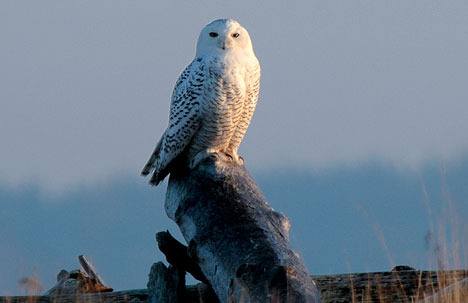Earlier this week I was showing off Whidbey to an out-of-town writer friend. While driving west from Coupeville out across the open farmland, she spotted three Trumpeter Swans in a stubbly field right next to the road.
I screeched to a stop.
The midday sun spotlighted the large white bodies and, as the birds lifted their heads, we saw their black bills and eyes. These swans can stretch five feet tall.
My friend, although a keen naturalist from Eugene, Ore. was ecstatic to see this species in the wild.
I explained to her that here on Whidbey we are often the southern migration stop of five special white-bodied, winter visitors.
Along with the Trumpeter and Tundra Swans, we also see three “snowy” bird species: Snow Geese, Snowy Owls and Snow Buntings.
The Snow Geese are smaller than the swans at two-and-one-half feet. But what they lack in stature they make up for in numbers, gathering in huge flocks of tens of thousands of birds. Their flocks blanket the fields and cloud the skies of the Skagit Flat’s Fir Island, just north of Whidbey.
Those dazzling white birds are one of the signature wonders of our state, natural or otherwise. You don’t even have to leave your car to become immersed in their gaggles and surrounded by swirling geese flurries.
Snowy Owls are harder to find, fewer in number and less dependable visitors. These birds breed on the tundra and, depending on the availability of their winter prey, a few straggle south and settle into open habitats, such as the driftwood-laden spit near Crockett Lake. If a Snowy Owl finds a good territory, it often stays put for the winter.
Although some Snowy Owls are pure white, it’s the younger birds that are forced farther south to find winter-feeding territory. These immature owls are laced with black patterning.
Our final white winter visitor is the Snow Bunting, aptly named for its white color and connection to the high arctic regions. These seven-inch, finch-like birds are white with black wings.
In winter, showing a rusty wash over the upper parts, they typically stay well north and east of us. A few birds commonly winter in the open areas around Bellingham.
Two winters ago a small flock of Snow Buntings hung out near the viewing platform on the east end of the spit at Crockett Lake. Snow Buntings continually move around their winter territory, so catching a view is hit-or-miss.
Why are all five of these winter visitors plumed in bright white?
The first answer to pop into our minds is camouflage against their typical white, snowy landscape. A good example is the ptarmigan, which lives year-round in high elevations. These ground-loving birds molt into a speckled brownish plumage during the summer and change to a pure white plumage, as snow covers their habitat.
However, when we consider the heat absorption value of dark plumage we might wonder why these “snowy” species, all good fliers, would give up radiant heat energy for camouflage. As with many avian mysteries, the simple rules don’t always hold true.
Two other factors are of greater importance to body heat retention: ambient wind speed and how deeply the absorbed radiation penetrates through the plumage. That penetration is further influenced by whether the feathers are sleeked down or held erect. Factoring together these complicated considerations, it turns out that at low temperatures with high wind speeds — the more typical weather of the high tundra — erect white feathers will absorb and retain radiant heat better than dark feathers. (“The Birder’s Handbook” by Ehrlick, Dobkin and Wheye.)
For these visitors, wearing winter white, it turns out, is an all-around good idea.
For us, it’s the perfect time to view these white-bodied species. Check out the Whidbey Audubon Web site www.whidbeyaudubon.org for guided trips, or venture up to Fir Island on your own. Just watch the sky for swarming flocks of bright white birds and follow the glistening clouds.
Frances Wood is the author of “Brushed by Feathers: A Year of Birdwatching in the West.” Check out her Web site at franceswood.net.


